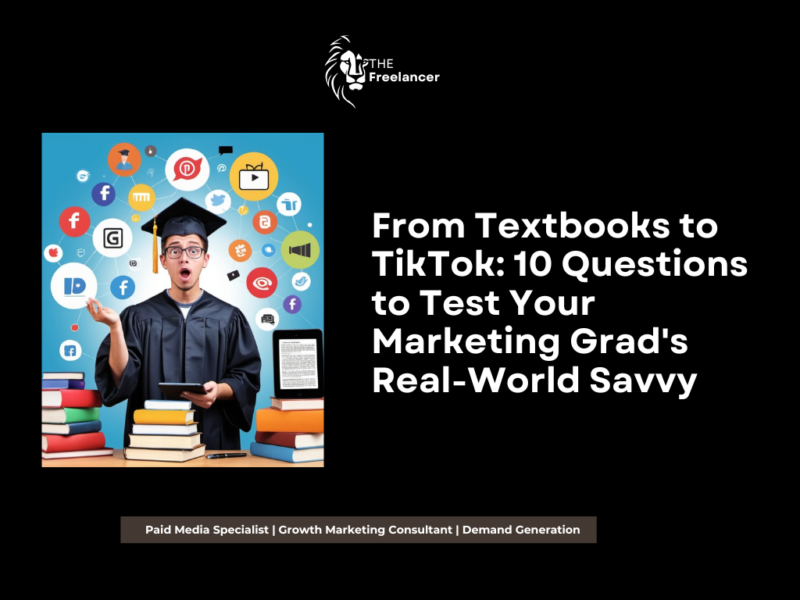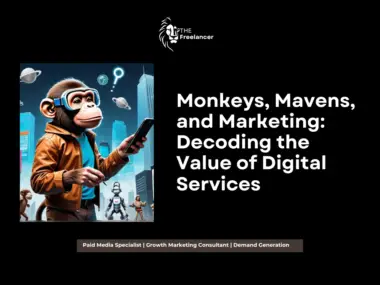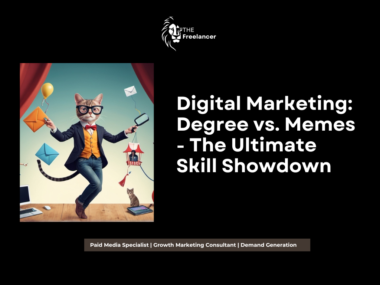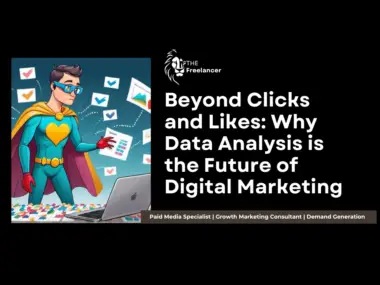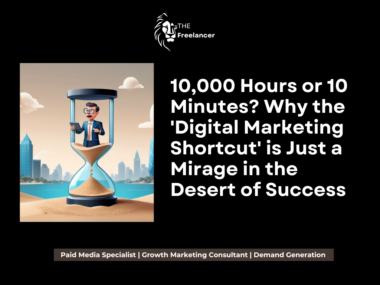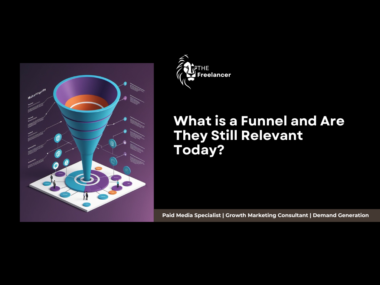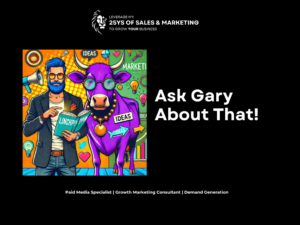Ah, the fresh-faced marketing graduate. They’ve just spent four years and approximately £40,000 (or £140,000 if they went for that ‘prestigious’ private school experience) learning about the cutting-edge world of… MySpace and AOL Instant Messenger. Okay, maybe not that outdated, but in the time it took them to earn their degree, TikTok went from a Kesha song to a global phenomenon, and Meta went from a sci-fi concept to Mark Zuckerberg’s fever dream.
As an employer, you’re now faced with the daunting task of figuring out if your bright-eyed candidate’s knowledge is as fresh as their student loan debt. Fear not! I’ve compiled a list of questions that will help you separate the social media savants from the “Is Vine still a thing?” crowd. So, grab your favourite caffeinated beverage (perhaps from the same brand that’s been sponsoring your candidate’s ramen dinners for the past four years), and let’s dive into the 10 critical questions to ask your next marketing degree hire. Who knows? You might even learn something new yourself – like what the kids are calling “fleek” these days.
Now, let’s get into those questions that will help you determine if your candidate’s marketing knowledge is more “2024” or “2004”
Explain LinkedIn’s Economic Graph and how it impacts the platform’s functionality for marketers.
A knowledgeable candidate should discuss:
- Definition: The Economic Graph is LinkedIn’s digital mapping of the global economy, including companies, jobs, skills, and other professional data points.
- Data collection: How LinkedIn aggregates and analyses data from user profiles, job postings, company pages, and user interactions.
- Machine learning: The role of AI in processing and interpreting the vast amount of data in the Economic Graph.
- API integration: How third-party applications can access and utilise Economic Graph data through LinkedIn’s API.
- Targeting capabilities: How marketers can use Economic Graph data for precise audience targeting in LinkedIn advertising campaigns.
- Content recommendations: How the Economic Graph influences the content and connections suggested to users.
- Skill gap analysis: How the platform identifies emerging skills and industry trends based on Economic Graph data.
- Recruitment tools: How LinkedIn Recruiter and other hiring solutions leverage the Economic Graph for talent matching.
- Industry insights: How marketers can use Economic Graph data for market research and competitive analysis.
- Privacy considerations: How LinkedIn balances data utilisation with user privacy and data protection regulations.
This question tests the candidate’s understanding of LinkedIn’s unique data infrastructure and its applications for marketing, demonstrating a deeper technical knowledge of the platform beyond basic usage.
Explain X’s (Twitter’s) API v2 and how it impacts marketing strategies on the platform.
A savvy candidate should cover:
- API v2 Overview: Understanding the shift from v1.1 to v2, including improved data access and enhanced functionality.
- Endpoints: Familiarity with key endpoints like Tweet lookup, User lookup, and Filtered stream, and how they can be used for marketing insights.
- Rate Limits: Understanding the new rate limit structure and how it affects data collection and automation for marketing purposes.
- Authentication: Explaining the OAuth 2.0 authentication process and its importance in securing API access.
- Compliance: Awareness of X’s Developer Policy and how it impacts data usage in marketing campaigns.
- Streaming Capabilities: Understanding the differences between sampled and filtered streams, and how they can be used for real-time marketing insights.
- Engagement Metrics: How the API provides access to engagement data (likes, retweets, replies) and its relevance to measuring campaign success.
- Conversation Threading: Explaining how the API represents conversation threads and its implications for tracking brand discussions.
- Media Attachments: Understanding how media (images, videos, GIFs) is represented in the API and how this affects content strategy.
- Geospatial Data: How location information can be accessed through the API for geo-targeted marketing campaigns.
- Academic Research Access: Awareness of the Academic Research product track and its potential for in-depth market research.
A candidate who can discuss these aspects of X’s API v2 demonstrates a deep technical understanding of the platform’s capabilities, showing they can leverage advanced features for sophisticated marketing strategies on X.
What are the four ways to monetise TikTok today, and can you explain what they are?
A knowledgeable candidate should be able to identify and explain these four primary monetisation methods on TikTok:
a) TikTok Creator Fund: A program that pays creators for their content based on views and engagement.
b) Brand Partnerships: Creators collaborate with brands for sponsored content.
c) TikTok Shop: An e-commerce feature allowing creators to sell products directly through their videos.
d) Live Gifts: Viewers can send virtual gifts during live streams, which can be converted to cash.
Why is TikTok facing potential bans in the USA?
A well-informed candidate should mention:
- Data privacy concerns: Fears that the Chinese government could access user data through ByteDance, TikTok’s parent company.
- National security issues: Concerns about potential influence operations or information manipulation.
- Legislative actions: Mention of the RESTRICT Act and state-level bans on government devices.
- Ongoing negotiations: TikTok’s efforts to address concerns through Project Texas and data storage agreements.
How does the data system work on the backend of Instagram?
A candidate with a strong technical understanding should discuss:
- Data collection: How Instagram gathers user data from interactions, content, and device information.
- Data storage: Use of distributed databases and cloud storage systems.
- Data processing: Implementation of machine learning algorithms for content recommendations and ad targeting.
- API integration: How third-party apps can access and use Instagram data.
- Privacy measures: Data encryption and user privacy controls.
How does the algorithm work on YouTube?
A candidate should be able to explain key aspects of YouTube’s recommendation algorithm:
- Watch time: The importance of viewer retention in video recommendations.
- User engagement: How likes, comments, and shares affect a video’s visibility.
- Personalisation: How user history and preferences influence recommendations.
- Click-through rate: The impact of thumbnails and titles on video performance.
- Freshness and relevance: How YouTube balances new content with established popular videos.
- Topic modelling: How YouTube categorises and connects related content.
How do you optimise a website for voice search?
A candidate should mention:
- Natural language processing: Understanding how people use conversational queries in voice search.
- Long-tail keywords: Focusing on more specific, question-based keywords.
- Structured data: Implementing schema markup to help search engines understand your content.
- Mobile optimisation: Ensuring your website is mobile-friendly, as most voice searches are conducted on mobile devices.
- Local SEO: Optimising for local search queries, as voice searches often have local intent.
What are the latest trends in influencer marketing?
A well-informed candidate should discuss:
- Micro-influencers: Collaborating with influencers who have smaller, but highly engaged followings.
- Authenticity: Prioritising genuine, relatable content over polished, staged posts.
- Long-term partnerships: Building ongoing relationships with influencers rather than one-off collaborations.
- Niche influencers: Working with influencers who have expertise in specific industries or interests.
- Performance-based compensation: Paying influencers based on the results they deliver, such as sales or leads.
What are the key technical considerations for optimising video content across different platforms?
A knowledgeable candidate should discuss:
- Aspect ratios: Understanding the ideal dimensions for various platforms (e.g., 16:9 for YouTube, 9:16 for TikTok, 1:1 for Instagram feed).
- Video codecs: Familiarity with common codecs like H.264 and HEVC (H.265) and their impact on file size and quality.
- Bitrate optimisation: Balancing video quality with file size for efficient streaming across different network conditions.
- Adaptive bitrate streaming: Implementing technology that adjusts video quality based on the viewer’s internet speed.
- Thumbnail optimisation: Creating compelling, high-resolution thumbnails that are optimised for each platform.
- Closed captions and subtitles: Implementing accurate, platform-specific caption files (e.g., SRT, VTT) for accessibility and engagement.
- Video SEO: Optimising titles, descriptions, and tags for search ability on platforms like YouTube.
- Frame rates: Understanding the impact of different frame rates (e.g., 24fps, 30fps, 60fps) on viewer perception and platform requirements.
- Audio quality: Ensuring clear audio with appropriate levels and considering platform-specific audio requirements.
- Video length: Tailoring video duration to platform norms and audience preferences (e.g., short-form for TikTok, longer for YouTube).
A candidate who can discuss these technical aspects demonstrates a deep understanding of video marketing beyond just content creation, showing they can optimise video performance across various digital platforms.
How do you create a successful content marketing strategy?
A candidate should discuss:
- Audience research: Understanding your target audience’s needs, preferences, and pain points.
- Content planning: Developing a content calendar with a mix of formats, such as blog posts, videos, and infographics.
- SEO optimisation: Ensuring your content is optimised for search engines to drive organic traffic.
- Distribution: Promoting your content across various channels, including social media, email, and partnerships.
- Performance measurement: Tracking metrics such as traffic, engagement, and conversions to evaluate success and refine your strategy.
By asking these questions, you’ll gain insight into the candidate’s understanding of current digital marketing platforms and trends. A strong candidate should demonstrate not just theoretical knowledge, but also practical understanding and the ability to apply this knowledge to real-world marketing strategies. Remember, the digital marketing landscape is constantly changing, so look for candidates who show a commitment to ongoing learning and adaptability in addition to their current knowledge. And if they can explain complex concepts with a touch of humour, you’ve likely found a gem!
